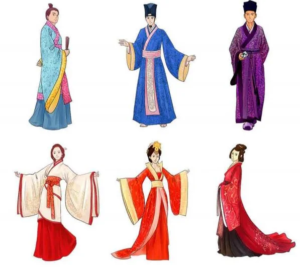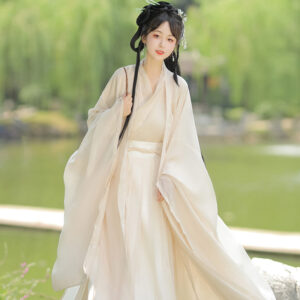

Hanfu, the traditional clothing of the Han Chinese, is crafted from a variety of materials that reflect both historical practices and modern adaptations. Here are the most common materials used in Hanfu:
1. Silk
- Description: Silk is the most prestigious fabric traditionally used in Hanfu. It is known for its luxurious feel, smooth texture, and natural sheen.
- Varieties: Different types of silk, such as mulberry silk, tussah silk, and damask silk, are commonly utilized. Mulberry silk is particularly prized for its durability and softness.
- Cultural Significance: In ancient China, silk symbolized status and wealth, often reserved for royalty and aristocrats. Today, it remains a popular choice for ceremonial Hanfu, especially during weddings and significant cultural celebrations.
2. Cotton
- Description: Cotton is a breathable and comfortable fabric that became popular during the Southern and Northern Dynasties.
- Usage: It is often used for everyday wear due to its affordability compared to silk. Cotton’s hypoallergenic properties make it suitable for various skin types.
- Practicality: Cotton Hanfu typically features simpler designs that emphasize comfort and functionality.
3. Hemp
- Description: Hemp is valued for its incredible durability and eco-friendly nature. It has been a cornerstone of traditional Chinese textiles since ancient times.
- Characteristics: Known for its breathability and moisture-wicking properties, hemp is particularly suitable for summer garments.
- Texture: Hemp has a rustic texture that contrasts beautifully with smoother fabrics like silk and cotton.
4. Ramie
- Description: Ramie is a plant-based fabric known for its strength and breathability.
- Usage: Often used in summer Hanfu due to its lightweight nature, ramie becomes softer with each wash, enhancing comfort over time.
5. Wool
- Description: While not as common in traditional Hanfu, wool is used in colder northern regions of China for added warmth.
- Characteristics: Wool garments are thick and woven to retain heat effectively, making them practical for winter wear.
6. Fur
- Usage: Fur is primarily used as trim or lining in Hanfu to provide extra warmth and luxury, especially in ceremonial or high-status garments.
- Regional Variations: The use of fur is more prevalent in northern regions where colder climates necessitate additional insulation.
7. Synthetic Fabrics
- Description: Modern adaptations of Hanfu often incorporate synthetic fabrics like polyester blends.
- Advantages: These materials offer durability, ease of maintenance, resistance to wrinkles, and affordability, making Hanfu more accessible to a broader audience.
Summary Table of Common Materials Used in Hanfu
| Material | Description | Usage |
|---|---|---|
| Silk | Luxurious fabric with a smooth texture; symbolizes status | Ceremonial wear; weddings |
| Cotton | Breathable and comfortable; affordable alternative to silk | Everyday wear |
| Hemp | Durable and eco-friendly; suitable for summer garments | Lightweight summer attire |
| Ramie | Strong plant-based fabric; becomes softer with washing | Summer Hanfu |
| Wool | Thick fabric providing warmth; used in colder regions | Winter garments |
| Fur | Used as trim or lining; adds warmth and luxury | High-status or ceremonial garments |
| Synthetic Fabrics | Modern materials offering versatility; durable and easy to maintain | Everyday wear; contemporary adaptations |
Conclusion
The materials used in Hanfu reflect a rich historical tapestry that balances luxury with practicality. From the opulence of silk to the simplicity of cotton and hemp, each fabric contributes to the overall aesthetic and functionality of Hanfu. Modern adaptations continue to embrace these traditional materials while incorporating new options to appeal to contemporary tastes.
Share this post
Facebook
Twitter
LinkedIn
Pinterest
Recent Posts


What were the key features of Hanfu during the Tang Dynasty?
October 24, 2024

How did Hanfu styles vary during different Chinese dynasties?
October 24, 2024

What accessories are typically worn with Hanfu?
October 24, 2024

How do you choose the right Hanfu for different seasons?
October 24, 2024

Newsletter
Subscribe for our monthly newsletter to stay updated
Popular Categories
Related Post
Sed aliquam, tortor et sodales malesuada, lorem leo luctus tellus, quis interdum eros nibh in nunc. Cras dignissim malesuada, lorem leo luctus

What are the winter hanfu called?
October 24, 2024

What were the key features of Hanfu during the Tang Dynasty?
October 24, 2024

How did Hanfu styles vary during different Chinese dynasties?
October 24, 2024

What accessories are typically worn with Hanfu?
October 24, 2024

